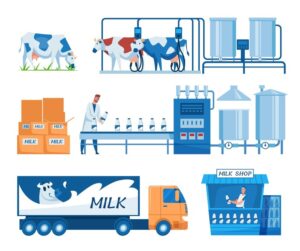Types of GST in India: CGST, SGST, IGST and UTGST Simplified
- 17 Dec 24
- 11 mins

Types of GST in India: CGST, SGST, IGST and UTGST Simplified
Key Takeaways
- GST unifies India's tax system by replacing multiple indirect taxes with a single framework comprising CGST, SGST, IGST, and UTGST.
- CGST and SGST apply to intrastate supplies, with the tax shared between the central and state governments, whereas IGST applies to interstate and import transactions.
- UTGST operates like SGST but applies exclusively to Union Territories, ensuring revenue autonomy in regions without state governments.
- Rule 88A mandates the priority use of IGST Input Tax Credit (ITC) before CGST and SGST/UTGST, helping businesses optimize tax liability management.
- IGST also enables seamless tax collection and distribution across states, promoting the free flow of goods, services, and transparency in interstate and international trade.
The Goods and Services Tax (GST) has brought about a significant transformation in collecting taxes in India, thereby impacting both the federal structure and the economy. Introduced in 2017, a complex system of indirect taxes was replaced with GST, which is a single tax framework. This change has brought significant changes in the financial landscape between the state and central government, greatly influencing the generation of revenues. Thus, gaining a thorough understanding of the impact of GST is important to grasp the effects on economic growth further.
Understanding the GST Framework
The Goods and Services Tax (GST) was implemented in India on July 1, 2017. GST framework is introduced particularly by the Government of India that emphasizes the elimination of indirect taxes such as excise duty, VAT, customs duty, entertainment tax and service tax, and it accumulates them under a single tax structure.
The two main forms of GST are intrastate level and interstate level. The former includes both CGST & SGST whereas the latter considers IGST and imports. Additionally, exports and supplies to SEZs are zero-rated following the GST framework.
The key features of the GST system include:
- Single tax structure: Here, various indirect taxes are combined into one, thereby making it simpler and hassle-free for businesses to comply.
- Multiple rates: Various goods and services available are taxed at different rates, which thereby causes complications in compliance.
- Input tax credit: Businesses must claim credit for taxes paid on inputs, thereby lowering the tax burden overall.
Under the GST regime, there is a single tax applicable which has 4 components:
- CGST: Central Goods and Services Tax
- SGST: State Goods and Services Tax
- UTGST: Union Territory Goods and Services Tax and
- IGST: Integrated Goods and Services Tax
💡 If you want to pay your GST with Credit Card, then download Pice Business Payment App. Pice is the one stop app for all paying all your business expenses.
Central Goods and Services Tax (CGST) Explained
The enactment of the CGST Act enables the Central Government to impose and collect taxes on goods and services supplied within the state. The full form of CGST is Central Goods and Services Tax and it applies to supplies of goods and services in interstate trade, with exceptions that are exempted from taxation.
Central Goods and Services Tax denotes the imposition of taxes on the provision of goods and services in India and is focused mainly on where they are being consumed. This indicates that the tax is applied to the state where the consumption of goods and services takes place.
CGST rate is usually fixed at 18% but can be reduced further through notification reference by the central government. It is applicable throughout India, including Jammu and Kashmir as per the Central Goods and Services Tax Act 2017.
State Goods and Services Tax (SGST) Explained
The full form of SGST is State Goods and Services Tax and it is a significant portion of the Goods and Services Tax (GST) structure in India. It is the state government that levies these taxes on intrastate sale of goods and services. SGST provides the state government with autonomous spending power on different developmental activities. SGST is distinguishable from CGST and IGST (Integrated Goods and Services Tax) as the first one deals with intrastate transactions while central government levies CGST and IGST apply only to interstate transactions.
The main aim of SGST is to create a unified tax system for the whole country. The State Goods and Service Tax Act 2016 governs SGST. SGST is not applicable to alcohol meant for human consumption. This tax is exclusively applicable to the transaction value of goods and services supplied, following the SGST Act’s Section 15. The transaction value means the price to be paid for the supplied goods and services.
As the name suggests, the state that consumes goods and services receives the tax revenue from SGST instead of the state where the goods are produced. The State Goods and Services Tax of 2017 assists in levying and collecting these taxes.
Union Territory Goods and Services Tax (UTGST) Explained
UTGST, also known as the Union Territory Goods and Services Tax, is an important component of the GST system in India. Just like how the SGST is being applied to intra-state supplies, the UTGST is also applicable to intra-Union Territory supplies of goods and services. The UTGST Act, 2017 is the governing body of administration and collection of UTGST. The main aim of UTGST is to ensure that the Union Territories also receive a significant portion of revenue and autonomy in taxation.
States are ruled by their elected governments. On the other hand, the Union Territories in India are ruled directly by the central government. Examples of union territories include Andaman and Nicobar Islands, Lakshadweep, Dadra and Nagar Haveli and Puducherry. Because these territories have no state governments, the UTGST framework is designed specifically to provide them with their own taxation rules and revenue generation system.
UTGST is applicable when the supply of goods and services takes place within a Union Territory (intra-UT). The output liabilities associated with a taxable individual under the UTGST Act include the following:
| Supply Type | Output Tax Liability | Section Applicable |
| Supplies in a Union Territory in the absence of a governing body | UTGST and CGST (within the UT) | Following Section 8(1) and 8(2) of the IGST Act |
| Supplies were carried out between a Union Territory without any governing body and a State or UT with a governing body | Integrated GST | As per Section 7(1) and 7(3) of the IGST Act |
| Supplies made between two Union Territories and in the absence of a governing body | Integrated GST (Between two or more UTs) | As per Section 7(1) and 7(3) of the IGST Act |
Integrated Goods and Services Tax (IGST) Explained
IGST stands for Integrated Goods and Services Tax. It is a tax levied on the interstate supply of goods and services in India. When a transaction takes place from one state to another with the involvement of the movement of goods and services, the collection of taxes is called IGST. The Central Government collects these taxes and then distributes them further to the respective states or Union Territories.
IGST primarily aims to simplify the tax system through the removal of the effects of taxes, maintaining transparency in the taxation system. It also helps to ensure that the tax revenues are distributed equally between the state and central government. It further aims to create a common market through the removal of inter-state barriers to trade and the promotion of the free flow of goods and services across India.
Let's consider an example of IGST. Suppose an interstate transaction takes place between a dealer in Maharashtra and a retailer in Kerala. In this scenario, the IGST will be split between the central and state government of Kerala.
On the other hand, the integrated tax for foreign tourists takes place in a similar way to exports, given that the international tourists are non-residents of India and visit the country for a specific tenure not exceeding six months. Thus, the Indian tax law facilitates the IGST refund paid to an international tourist who is leaving India on goods taken from anywhere outside the country. The amount is then further refunded. Such citizens however should have made a re-deposit to the respective tax head.
Steps to Set Off GST Amounts

The Government has revised the set-off order for Input Tax Credit, effective from March 29, 2019, to optimize the sharing of revenues between the state and central government. However, with the wrong application, these kinds of changes might cause increased working capital needs for businesses. To prevent this, it is essential to comprehend the new set off orders and assess the potential impact on operations.
To make the most of set off GST amounts, it is necessary for businesses to learn about specific rules regarding the use of ITC. Gaining proper knowledge will help to prevent mistakes and keep operations functioning smoothly over the period.
Here are the relevant provisions for the order of utilization of ITC following the new rules of GST:
Rule 88A of CGST Rules, 2017
Implemented concerning Notification No.16/2019-CT on March 29, 2019, Rule 88A has established a new priority for ITC utilization. Effective from April 1, 2019, it is mandated that IGST ITC is used initially for settling IGST liabilities. The surplus left is then further applied for making CGST or SGST/UTGST-related payments. Additionally, after exhaustion of IGST ITC, CGST, SGST, or UTGST ITC can be used.
Section 49A and Section 49B
Section 49A and Section 49B, being a significant part of the CGST Act, were introduced on February 1, 2019. Section 49A amends the IGST-first principle which requires the use of SGST, CGST, or UTGST ITC only after full utilization of IGST ITC. On the other hand, Section 49B provides the government the authority to prescribe the order and method of ITC utilization for CGST, SGST, IGST or UTGST payments, subject to specific recommendations of the Council.
The Bottom Line
The GST in India was introduced specifically to create a unified tax structure. CGST & SGST are applied specifically to intrastate transactions and are shared between the state and central governments, while IGST is applied to inter-state transactions and imports, thereby ensuring a seamless flow of taxes between states. On the other hand, UTGST operates the same as SGST but it is applicable only in Union Territories. Altogether, these components help in streamlining India's taxation system and enhance transparency.
FAQs
Can CGST and SGST be set off against IGST?
What are the rules for setting off CGST?
First: Set off against CGST liabilities.
Second: If there is any remaining credit, it can be utilized for IGST liabilities.
However, CGST credit cannot be used to set off SGST or UTGST liabilities as per the GST rules.
What is the GST rule for 180 days payment?
What is ITC set off in GST?
IGST Credit → IGST, then CGST/SGST.
CGST Credit → CGST, then IGST.
SGST/UTGST Credit → SGST/UTGST, then IGST.
ITC cannot be cross-utilized between CGST and SGST/UTGST.
What is the punishment for not paying GST?
Interest: 18% per annum on the unpaid tax amount.
Penalty: 10% of the unpaid tax or ₹10,000, whichever is higher.
In cases of fraud or tax evasion, the penalty can be 100% of the tax due, and imprisonment may be imposed under Section 132 of the CGST Act.
 By
By 

















